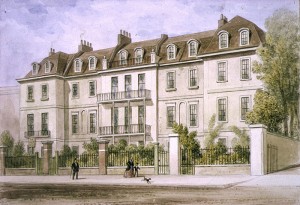< Previous – Chapter ToC – Next >
Mr. Brunel’s School Life

Mr. Brunel’s first recollections were of the house at Chelsea; and in 1814, when he was eight years old, he commenced his school life under the Rev. Weeden Butler, who resided in the neighbourhood. Previously to his going to Mr. Butler, he had been taught Euclid by Sir Isambard; and he had also a great talent for drawing, for which he had been remarkable even from four years old. His drawings were beautifully precise and neat, but, when the subject admitted of it, full of vigour and picturesque effect.
After some time he was sent to Dr. Morell’s school at Hove, near Brighton. The following extract is taken from one of his letters home in 1820:
I have past Sallust some time, but I am sorry to say I did not read all, as Dr. Morell wished me to get into another class. I am at present reading Terence and Horace. I like Horace very much, but not as much as Virgil. As to what I am about, I have been making half a dozen boats lately, till I have worn my hands to pieces. I have also taken a plan of Hove, which is a very amusing job. I should be much obliged to you if you would ask papa (I hope he is quite well and hearty), whether he would lend me his long measure. It is a long eighty-foot tape; he will know what I mean. I will take care of it, for I want to take a more exact plan, though this is pretty exact, I think. I have also been drawing a little. I intend to take a view of all (about five) the principal houses in that great town, Hove. I have already taken one or two.
In the intervals of his classical studies he seems to have employed himself, not only in making a survey of Hove in its existing state, but also in a critical examination of the works in progress for its enlargement. It is told of him that one evening he predicted the fall, before the next morning, of some houses which were building opposite the school, and laid a bet on the subject, which his companions readily accepted. He had noticed the bad way in which the work was done, and that the stormy weather, which appeared to be setting in for the night, would probably blow the walls down. In the morning he claimed the wager, for the buildings had fallen in the night.
Except from November 1820 to August 1822, when he was at the College Henri Quatre at Paris, [1] Mr. Brunel was so very little absent from home that he became thoroughly acquainted with all his father’s undertakings. Among these was the veneering machinery at Battersea, remarkable for the great diameter of the saw, the steadiness of its motion, and the mechanical arrangements for clearing the veneer from the saw; also the works at the Government establishments at Woolwich and Chatham, and the machinery for making shoes. They have been fully described by Mr. Beamish; but the mere mention of their names is enough to show how great were the advantages enjoyed by Mr. Brunel in receiving from his father his early professional education.
From the year 1823 Mr. Brunel was regularly employed in his father’s office. It was in the early part of this year that the project of the Thames Tunnel first began to occupy Sir Isambard’s attention; but he was also engaged at that time in other works of great importance, among them the suspension bridges for the lle de Bourbon, and designs for bridges of the same character over the Serpentine, and over the Thames at Kingston. [2] Some account of the Bourbon bridges, and also of experiments with carbonic acid gas, on which Mr. Brunel was engaged, will be found in the notes to this chapter.
[1] He was sent to Paris to recover his knowledge of French, which had got rather rusty at school, and also to study mathematics. He retained through life a great admiration of the method of teaching this subject which was adopted in France. In addition to the time spent in the study of mathematics and languages, Mr. Brunel occupied himself on his holidays in examining the various engineering works going on in Paris, and he used to send his father drawings and descriptions of them. [2] Sir Isambard was also consulted upon a proposed suspension bridge over the Tamar at Saltash, where Mr. Brunel subsequently built the Royal Albert Bridge.